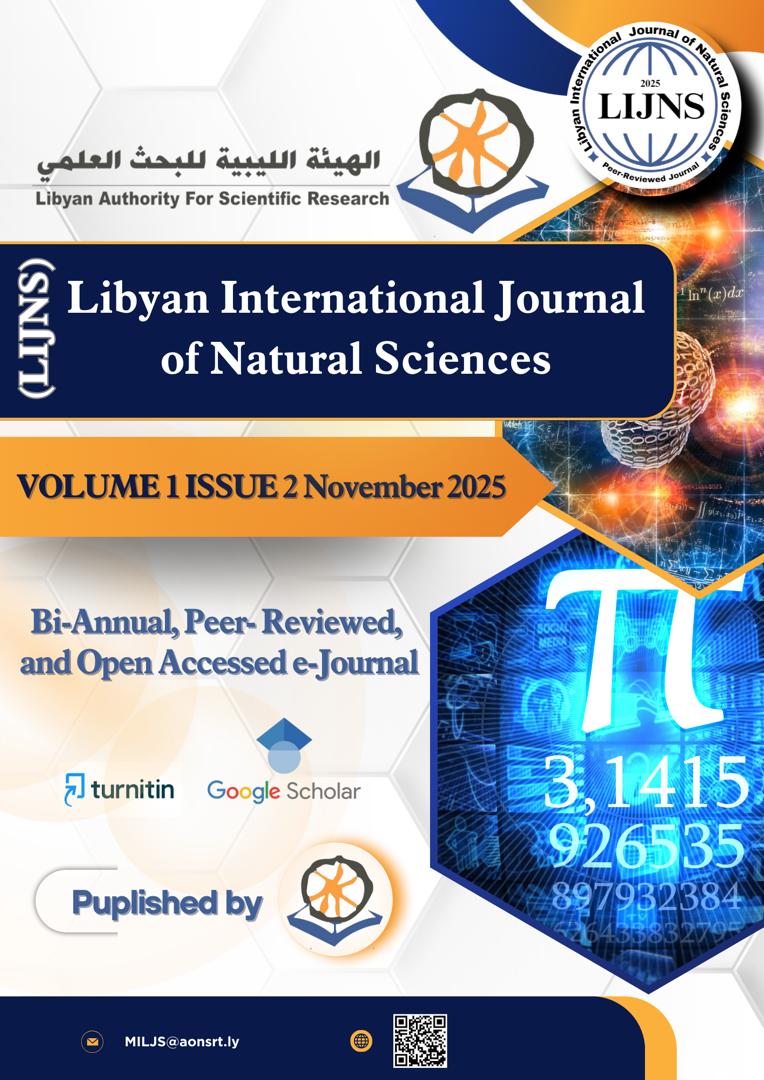Application of the Binary Logistic Regression Model in Studying Coronary Artery Disease Among Patients Undergoing Catheterization
Keywords:
Coronary Artery Disease (CAD); Binary Logistic Regression; Risk Factors; Predictive Modeling; ROC Curve Analysis.Abstract
Coronary artery disease (CAD) is a leading cause of morbidity and mortality worldwide, underscoring the need for reliable methods to identify key risk factors. This study applied binary logistic regression to assess the most significant predictors of CAD among 856 patients who underwent cardiac catheterization at the Benghazi Heart Center between 2020 and 2022. The independent variables examined were age, gender, diabetes, blood clots, smoking, and hypertension. Results from contingency tables and logistic regression analysis revealed that age, male gender, diabetes, and blood clots were statistically significant predictors of CAD (p < 0.05), with diabetes and blood clots having the highest odds ratios (OR = 2.851 and OR = 2.941, respectively). All regression methods (Enter, Forward Stepwise, Backward Stepwise) demonstrated consistent findings, with a correct classification rate of 78.2% and AUC values around 0.727, indicating good model performance. These findings confirm that binary logistic regression is an effective tool for identifying high-risk groups and can support clinical decision-making and preventive healthcare strategies.
References
[1] A. Mustafa, R. Hassan, N. Omar, et al., "Factors influencing heart disease in Sudan: a logistic regression approach," J. Health Stat., vol. 12, no. 3, pp. 45–60, 2015.
[2] A. Pannu and I. N. El-Saeiti, "Evaluating predictive accuracy and model selection in logistic regression: a statistical approach using sensitivity, specificity, and ROC analysis," Int. J. Manag., vol. 16, no. 1, pp. 16–23, 2025, doi: 10.34218/IJM_16_01_002.
[3] A. Zulkiflee, H. Rahman, and P. Singh, "Heart disease prediction using binary logistic regression: a comparative study," Int. J. Med. Inform., vol. 145, pp. 104–112, 2021.
[4] A. G. S. Alzwawy and R. F. Aldarnawi, Hyperferritinemia as a Potential Predictor of COVID-19 Severity and Mortality among a Sample of Quarantine Hospital’s Patients in Ajdabiya /Libya, 2025. [Online]. Available: http://www.doi.org/10.62341/arsh1727
[5] B. Douma, J. Smith, K. Lee, et al., "Predicting heart disease using logistic regression: a case study," Int. J. Epidemiol., vol. 47, no. 2, pp. 123–135, 2018.
[6] D. G. Kleinbaum, L. L. Kupper, and K. E. Muller, Applied regression analysis and other multivariable methods, Boston: PWS-Kent, 1987.
[7] D. W. Hosmer and S. Lemeshow, Applied logistic regression, 2nd ed., New York: Wiley, 2000.
[8] I. N. El-Saeiti and A. Pannu, "Evaluating the predictive power of logistic regression models in classifying binary outcomes," Int. J. Educ., vol. 5, no. 2, pp. 93–103, 2024, doi: 10.34218/IJE_05_02_007.
[9] M. D. Intriligator, Econometric models, techniques, and applications, Englewood Cliffs: Prentice-Hall, 1978.
[10] M. J. Norusis, SPSS for Windows: base system user’s guide, Chicago: SPSS Inc., 1993.
[11] R. D. Retherford and M. K. Choe, Statistical models for causal analysis, New York: Wiley, 1993.
[12] S. Chand, R. Patel, J. Kim, et al., "Risk factors for coronary artery disease: a logistic regression analysis," Am. J. Cardiol., vol. 95, no. 6, pp. 789–795, 2005.
[13] S. Sharma, Applied multivariate techniques, New York: Wiley, 1996.
[14] S. Swain, L. Thompson, M. Yang, et al., "Predictive modeling of coronary artery disease using logistic regression," J. Cardiovasc. Res., vol. 58, no. 4, pp. 456–470, 2019.
[15] T. Chap, Applied logistic regression analysis, New York: Wiley, 1998.
[16] World Health Organization, "cardiovascular diseases (CVDs): key facts," Geneva: WHO, 2021. [Online]. Available: https://www.who.int/news-room/fact-sheets/detail/cardiovascular-diseases-(cvds). [Accessed: Jan. 30, 2025].

Downloads
Published
How to Cite
Issue
Section
License
Copyright (c) 2025 Libyan Authority for Scientific Research

This work is licensed under a Creative Commons Attribution-NonCommercial-ShareAlike 4.0 International License.





 Published by:
Published by: 